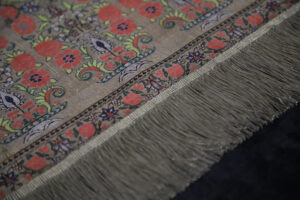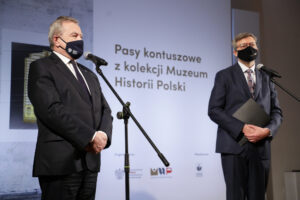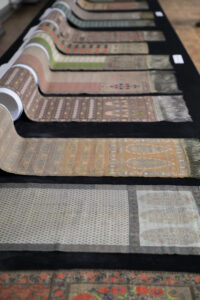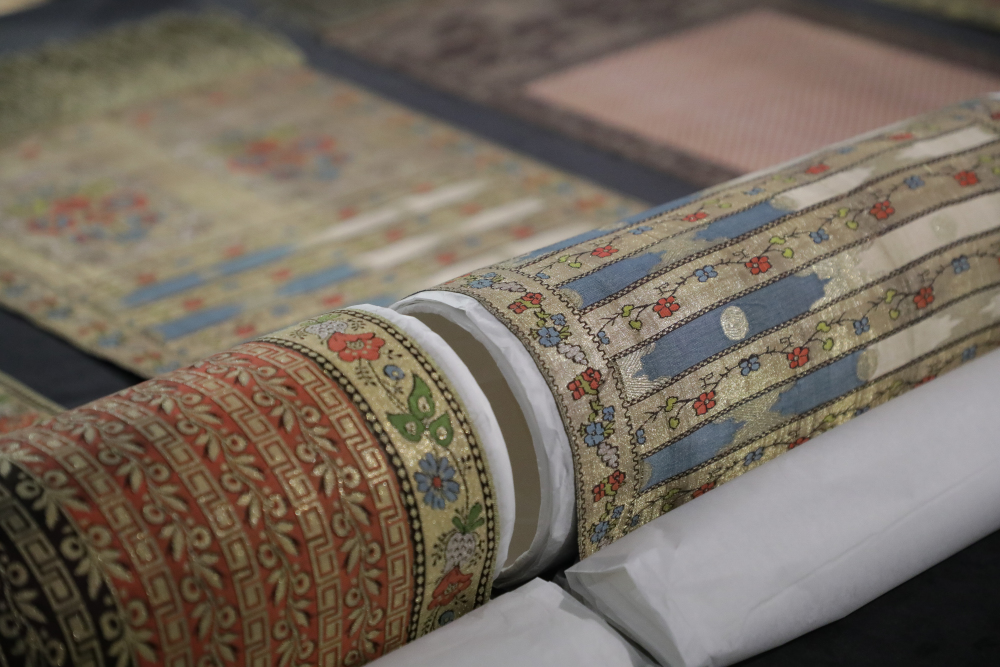The Polish History Museum (PHM) has acquired an extraordinarily precious collection of 22 sashes worn around the waist over the kontush (an outer robe with its sleeves cut from the armhole to the elbow), a key element of the Polish nobility’s attire. The purchase has been funded by the Ministry of Culture and National Heritage. The collection includes richly decorated bands originating from the most renowned Polish and foreign manufactories. They were shown for the first time during a press conference held at the Kubicki Stables of Warsaw’s Royal Baths on 9 December 2021. The event was attended by Deputy Prime Minister and Minister of Culture and National Heritage Prof. Piotr Gliński and Director of the Polish History Museum Robert Kostro.
Kontush sashes, also called Polish or Slutsk bands, are one of the most characteristic and important elements of the Polish nobility’s attire. The peak of popularity of this clothing item came in the 18th century, when its typical form was established. Imported from the East by Armenians (e.g. from Persia and Turkey), the sashes began to be manufactured in the Polish-Lithuanian Commonwealth in the first half of the 18th century. Other important centres of their production included the manufactories of Paschalis Jakubowicz (Warsaw and Lipków), a manufactory in Kobyłka and small ‘Persian fabric workshops’ in Krakow. Such sashes were also made in a royal manufactory in Grodno. A large foreign centre for their production was located in Lyon, where fabrics copying the decorative motifs from Polish ‘Persian fabric workshops’ were produced.

‘For a number of years, we have been systematically building the collection of the Polish History Museum. We present and popularise a unique thing. Polish sashes are an element of the nobility’s dress that was most developed in the 18th century. These 22 bands are of greater value than even the Enigma we bought,’ said Deputy Prime Minister and Minister of Culture and National Heritage Prof Piotr Gliński.
‘We have here 22 sashes from various manufactories, all important Polish ones. Here we have the Slutsk workshop of the Radziwiłłs, Paschalis Jakubowicz’s one, the Kobyłka msnufsctory and, last but not least, the royal workshop of Grodno (…) We are very happy to have such a complete, beautiful and splendid collection, because we want our museum to have a balanced character, i.e. we have multimedia and scenography, but the most important thing at the heart of every museum is the original artefacts after all. These are museum exhibits, historical monuments,’ Director of the Polish History Museum Robert Kostro pointed out.

In the collection purchased by the PHM there are both products of Polish and foreign ‘Persian fabric workshops’. The first group includes sashes from the Radziwiłłs’ manufactory in Slutsk (5), Grodno manufactory (2), Kobyłka (2), and four belts made in the Paschalis Jakubowicz manufactory. Among the bands made outside the Commonwealth, the majority are French imports (six Lyon sashes), but there are also single pieces from India, Turkey and Russia. The majority of the bands in the collection were made in the second half of the 18th century, while two or three of them come from the 19th century. The oldest sash in the collection is a double-sided one made in an Armenian workshop in Istanbul in the first half of the 18th century. Except for two Lyon bands made of silk, all the others were woven with silver and gold threads. The sashes also represent different styles and motifs of decoration.
Four of them have a very interesting provenance, coming from the collection of Władysław August Kościelski (1886–1933), a publisher, poet and patron of the arts. Three of them, as indicated by sewn-on labels, could have been entered for the prestigious International Exhibition of Persian Art held in London in 1931. It can be assumed that only one of them, the Indian sash, was eventually exhibited as the others are not listed in the exhibition catalogue.

Because of the variety of makers, types and decorative motifs, the entire collection is a perfect illustration of one of the most important elements of the Polish nobility’s dress, which makes it unique. Some of the purchased sashes will be placed on the Permanent Exhibition and displayed alternately in the Old Commonwealth Gallery and in the Gallery of the 19th Century.
Photography by Danuta Matloch / Ministry of Culture and National Heritage





